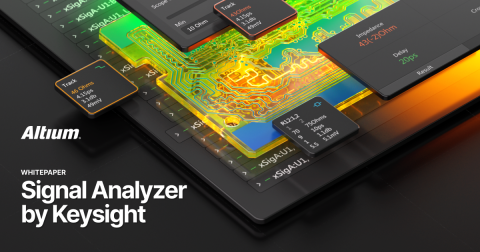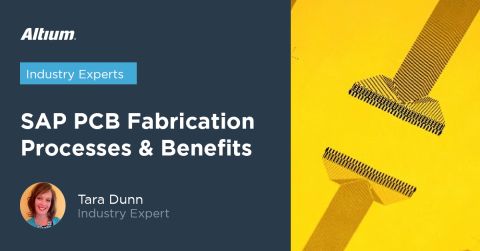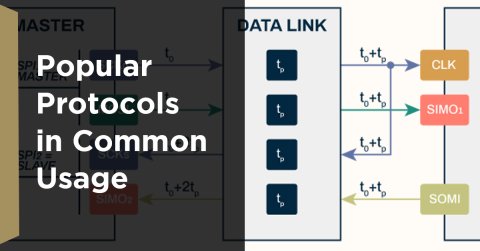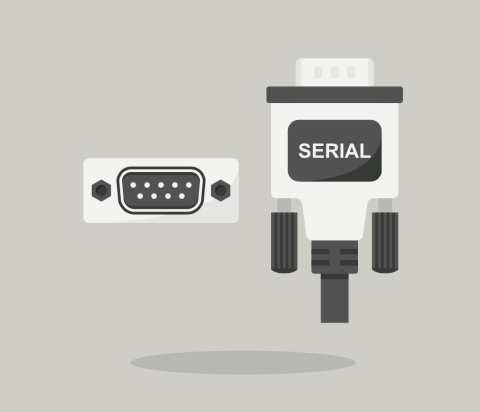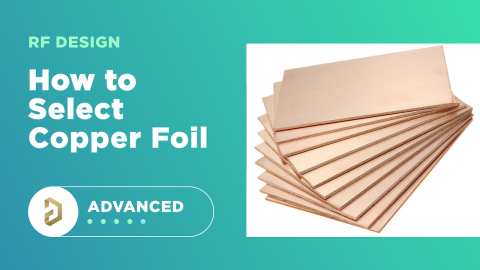S11 Parameter vs. Return Loss vs. Reflection Coefficient: When Are They the Same?

S-parameters are an often misunderstood topic for the intrepid RF/SI/PI engineer, and I even find myself questioning my understanding at times. One reason I’ve found that this useful set of signal integrity metrics is often misunderstood is that there are copious online resources with different definitions and explanations, all of which are given for different systems. In addition, S-parameters sometimes get used interchangeably with return loss, insertion loss, and reflection coefficient, and often without context.
In particular, there seems to be the occasional confusion around the difference between return loss vs. reflection coefficient, as well as how these relate to the S11 parameter. The important thread here is this: all of these quantities describe the reflection of a propagating wave off of a load, whether it’s a terminated transmission line or a circuit network. Let’s look at these different definitions and show when they start to correspond to each other.
Key Takeaways
- S-parameters, return loss, and reflection coefficient all describe wave reflections, but aren’t interchangeable. Formally, return loss is defined from the reflection coefficient Γ, and S11 is the negative of return loss (often plotted without the sign).
- S11 is the reflection between a port’s reference impedance and the input impedance of the whole network, so it depends on all elements in the circuit, not just a single load or characteristic impedance.
- For real impedances, power and voltage reflection coefficients are the same. With complex impedances they differ and depend on the specific S-parameter definition used.
- In transmission lines, S11 for very long lines converges to the usual reflection coefficient, while shorter lines show strong length-dependent resonances. Understanding this relationship is key to correctly interpreting simulation and measurement results.
Breaking Down Reflectance Formulas
Since S11 is sometimes used interchangeably with return loss and reflection coefficient, are they ever really the same? The answer is they are sometimes negatives of each other, and sometimes the magnitudes of all three quantities are equal in limited cases and in certain frequency ranges. The formulas shown below define return loss in terms of the reflection coefficient:

Because the reflection coefficient Γ < 1, then the return loss will have a positive dB value. When you look at a graph of a return loss formula, the negative sign is often omitted and is sometimes used interchangeably with the S11 parameter. Formally, S11 is the negative of return loss and has a negative dB value:

For transmission lines, and likely due to the way the data are displayed on graphs, S11 is often set equal to the reflection coefficient defined between the source/load and the transmission line characteristic impedance, which is only correct for a specific situation of a long transmission line. In general, we need the line's input impedance, which might be equal to the load impedance in specific circuit networks (short transmission lines). However, as we’ll see below, circuits with propagating waves will have S11 that eventually converges to the reflection coefficient.
Voltage or Power Reflection Coefficient?
Normally when we deal with S-parameters, we assume real sources and loads, as well as real reference impedances. In reality, load impedances are not always real, and the input bandwidth limit of a real I/O on an integrated circuit will have some reactance due to its input capacitance, as well as package parasitics.
- In the case where all the impedances invovled are real, then the power and voltage reflection coefficients are the same.
- In the case where the load and/or transmission line impedance values are imaginary, then the reflection coefficient used above depends on the S-parameter definition being used.
You can learn more about this issue in this related article on reflection coefficients.
S-Parameters Generalized
If you want to get a formula for S11 for a particular circuit network, it’s best to look at the ABCD parameters. There is a universal formula for converting between ABCD parameters and S-parameters. Once you have the S-parameters for a channel, you can determine return loss using the formula shown above.

Here, Z is the reference impedance for the incoming port (column 1 --> port 1, and column 2 --> port 2), which in the above are assumed to have equal values. See this article from Caspers (starting on page 87) for ABCD parameters for some common 2-port networks, including transmission lines. Here we have a simple definition of the S11 parameter:
- S11 is defined as the reflection coefficient between the port impedance and the network's input impedance (looking from the source end to the load end).
If we have different port impedances, we have:

Finally, with either of the above equations, we can calculate S11. Note above that Z01 is the port 1 reference impedance, and Z02 is the port 2 reference impedance. Together, they give a comprehensive definition of channel behavior.
The important point here is that the S11 parameter is not always equal to the reflection coefficient between a source impedance and the impedance of a single element. Because we're dealing with an input impedance, we need to consider the impedance of all other elements in the circuit network, not just the first element encountered in the network. S11 still describes reflection, it just uses the input impedance rather than characteristic impedance. To see one important example, let’s look at S11, return loss formula, and the reflection coefficient of a transmission line terminated at a known impedance. As we'll see, the value of S11 converges to the typical reflection coefficient between the source impedance and the characteristic impedance as we make the line longer.
S11 Parameter vs. Return Loss Formula vs. Reflection Coefficient for Transmission Lines
You can see when this occurs by comparing these different values for different line lengths. As an example, I’ve run a simple calculation using the method I’ve outlined in my upcoming IEEE EPS paper (more details from this conference are found here).
Here I’ve simulated S11 for three transmission lines with dispersion in the dielectric substrate. All three lines are identical except for their length, and the lines are terminated with a matched source and load (50 Ohms nominal impedance) with 1 pF load capacitance. For comparison, I’ve included a calculation of the reflection coefficient using the standard formula. The results are shown below.

The results for this calculation are quite interesting. First, we see that a signal on the short line (25 cm) with a severe mismatch at the capacitive load can experience strong resonances above ~500 MHz, leading to strong oscillations. In other words, above ~500 MHz, the line acts as a resonant cavity at particular frequencies. When the line is physically longer, we start to see when the line becomes electrically long as the resonances begin to appear at higher frequencies (see the 2.5 m line), In addition, the magnitude of the resonances is lower.
Once we look at the 25 m line (an extremely long channel for a PCB that would only appear through a cable or waveguide interface), it’s clear that the S11 parameter is almost identical to the reflection coefficient. The reflection coefficient curve almost entirely overlaps the S11 curve for the 25 m line (in grey). The only exception is seen from ~18-20 GHz, where we see a set of S11 resonances. I’ve zoomed in on this region in the graph below.

A few conclusions can be drawn here:
- The reflection coefficient for a transmission line can almost be seen as an “average” of S11 for a short transmission line.
- When the line is longer, we don’t have return loss resonance problems with high VSWR and radiation, but can we still have the same mismatch regardless.
- Although longer lines do not have the same return loss resonance problems as shorter lines, the channel is now dominated by S21 or insertion loss.
Convergence of S11 Parameter to the Reflection Coefficient
Why should we compare different line lengths at all? From the above equations, it should be clear that the reflection coefficient does not depend on line length, which suggests we may be able to derive a relationship between S11 and the reflection coefficient if the length can be eliminated from the S11 parameter. The general formula for S11 assuming different input port (ZS) and output port (ZL) reference impedances.

By taking limits to zero and infinity, we can see where S11 converges to return loss and reflection coefficient. Starting from S11 in terms of the line’s ABCD parameters (see the above article from Caspers), we can take the limit of |S11| for a line with characteristic impedance Z0 and input port impedance ZS (assume ZL = ZS and these are set to the reference impedance):

Remember, when the line length approaches infinity, the line's characteristic impedance becomes the load impedance. This nicely illustrates why we see the behavior shown above and how the transmission line's S11 parameter reduces to the reflection coefficient and return loss!
Note that this is applied at the input port (port #1), but we can take the same limit at the output port (port #2) and get the same result for S22 looking backwards into the transmission line. In addition, we have S11 = S22 when the two sides of the line are terminated to the exact same impedance, so we get the same result for both limits. This works out well for us, and it nicely shows where S11 and S22 correspond with return loss formula vs. reflection coefficient at each port.
Finally, using the definition of reflection coefficient with the source impedance and transmission line input impedance, we can get back to the above result by taking the same limit. This occurs because the line's input impedance converges to the characteristic impedance as the line length goes to infinity.
Conceptually, this means that the line acts like an isolated source impedance to create some reflection off the load impedance whenever the line is extremely long. Switching this around, the line acts like a very long load at the input port, so S11 will simply reduce to its reflection coefficient when the line is infinitely long. You can then use this result to interpret the numerical results from the integrated simulation features in Altium, which allow you to create accurate impedance profiles for your board and simulate time-domain waveforms of your signals.
Whether you need to build reliable power electronics or advanced digital systems, Altium Develop unites every discipline into one collaborative force. Free from silos. Free from limits. It’s where engineers, designers, and innovators work as one to co-create without constraints. Experience Altium Develop today!


